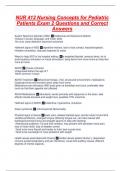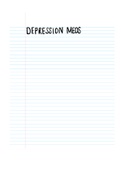NUR 412 Nursing Concepts for Pediatric
Patients Exam 2 Questions and Correct
Answers
Autism Spectrum disorder (ASD) ✅Intellectual and behavioral deficits
-Delays in social, language, and motor skills
-No cure, early detection improves outcomes
Hallmark signs of ASD ✅repetitive motions, lack of eye contact, impaired speech,
imitation (echolalia), reduced response to name
Ways to help ASD in the hospital setting: ✅a weighted blanket, sensory items, try to
avoid auditory simulation or visual stimulation, bring items from more home so they feel
more at home
ADHD ✅-Cause unknown
-Diagnosed before the age of 7
-More common in boys
ADHD Treatment ✅Behavioral therapy, (1st), structured environment, medications
Duplicate home environment when away from home
Medications are stimulants (BID dose given at breakfast and lunch, preferably after
lunch so that their appetite isnt affected.
ADHD Medications ✅Stimulants: works primarily with dopamine in the brain, side
effects include anorexia and weight loss, possible HTN, insomnia
Hallmark signs of ADHD ✅Inattentive, hyperactive, impulsive
Down syndrome ✅-Chromosomal Abnormality
Physical signs of downs ✅lower ears, wideset slanted eyes, shorter neck(1st and 2nd
vertebra problems), enlarged tongue (Sticking tongue out, can have issues with
feeding(recommend long and straight spoons to help with feeding)
-Atlantoaxial problems: 1st and 2nd vertebra, may present with persistent neck pain,
loss of motor skills, loss of bladder control
-Tend to be more flaccid and harder to hold, lack muscle tone
-Tend to be overweight or have problems with weight
Health issues associated with Downs ✅cardiac issues (patent ductus ), depressed
immune system(respiratory and ear infections), visual and auditory issues, different
degrees of mental capacity,
,Signs and Symptoms of aspiration pneumonia ✅Coughing
Vomiting
Restlessness
Confusion
Lethargy
Fever
Difficulty breathing
Conditions that increase the risk for Aspiration Pneumonia ✅Altered level of
consciousness
Dysphagia
Esophageal dysmotility
Neuro deficit
Gastroesophageal reflux
Persistent vomiting
Mechanical
ET tube
Trach
NG or OG tube
Treatment of aspiration pneumonia ✅Oxygen
Hydration
Tx of 2nd infection
Other causes of aspiration pneumonia -> Ingestion of hazardous or poisonous
substances ✅Especially Hydrocarbons
-Fuels, oils, polishes, waxes, solvents, aerosol,
propellants and refrigerants.
Found in the home or garage
Packed in attractive containers
Pleasant smell
Results in
Pneumonitis from aspiration
The liquids that are thinner, evaporate quicker and have a low surface tension are more
likely to be aspirated
In which of the following conditions is the fluid requirement for children decreased?
A. Burns
B. Fever
C. Vomiting
D. Increased intracranial pressure ✅D. Increased intracranial pressure
Depression of the central nervous system, manifested by lethargy, delirium, stupor, and
coma, is observed in which of the following?
A. Metabolic acidosis
,B. Respiratory alkalosis
C. Metabolic and respiratory acidosis
D. Metabolic and respiratory alkalosis ✅C. Metabolic and respiratory acidosis
When caring for a child with an intravenous infusion, the nurse should do which of the
following?
A. Change the insertion site every 24 hours.
B. Use a macrodropper to facilitate the prescribed flow rate.
C. Observe the insertion site frequently for signs of infiltration.
D. Avoid restraining the child to prevent undue emotional stress. ✅C. Observe the
insertion site frequently for signs of infiltration.
Which of the following is a major complication of total parenteral nutrition in children?
A. Anemia
B. Asthma
C. Liver disease
D. Renal impairment ✅C. Liver disease
Which of the following helps nurses understand how the respiratory tract in children is
different from that in adults?
A. Infants rely almost entirely on diaphragmatic-abdominal breathing.
B. Smooth muscle development in the airways increases until about age 12 years.
C. The configuration of the chest at birth is not as round as it becomes by adulthood.
D. With age there is a decrease in both number of alveoli and branching of terminal
bronchioles. ✅A. Infants rely almost entirely on diaphragmatic-abdominal breathing.
Which of the following is a measure of chest wall and lung distensibility?
A. Resistance
B. Ventilation
C. Compliance
D. Alveolar surface tension ✅C. Compliance
Which of the following blood oxygenation tests is the photometric measurement of
oxygen saturation?
A. Oximetry
B. Capnography
C. Arterial puncture
D. Transcutaneous oxygen and carbon dioxide monitoring ✅A. Oximetry
Nursing considerations related to the administration of oxygen in an infant include which
of the following?
A. Discontinue during feedings so child can be held.
B. Assess infant to determine how much oxygen should be given.
C. Ensure uninterrupted delivery of the appropriate oxygen concentration.
, D. Direct oxygen flow so that it blows directly into the infant's face in a hood. ✅C.
Ensure uninterrupted delivery of the appropriate oxygen concentration.
The nurse is teaching a mother how to perform chest physiotherapy and postural
drainage on her 3-year-old child, who has cystic fibrosis. To perform percussion, the
nurse should instruct her to:
A. Strike the chest wall with a flat-hand position.
B. Percuss before and after positioning for postural drainage.
C. Percuss over the entire trunk anteriorly and posteriorly.
D. Cover the skin with a shirt or gown before percussing. ✅D. Cover the skin with a
shirt or gown before percussing.
The nurse is caring for an infant with a tracheostomy when accidental decannulation
occurs. The nurse is unable to reinsert the tube. Which of the following should be the
nurse's next action?
A. Notify surgeon.
B. Perform oral intubation.
C. Try inserting larger tube.
D. Try inserting smaller tube. ✅D. Try inserting smaller tube.
A child is developing respiratory failure. Signs that the hypoxia is becoming severe
include:
A. Tachypnea.
B. Tachycardia.
C. Somnolence.
D. Restlessness. ✅C. Somnolence.
An immediate intervention when an infant chokes on a piece of food would be to do
which of the following?
A. Administer mouth-to-mouth resuscitation.
B. Open infant's mouth and perform blind finger sweep.
C. Have infant lie quietly while a call is placed for emergency help.
D. Position infant in a head-down, prone position, and administer five quick blows
between the shoulder blades. ✅D. Position infant in a head-down, prone position, and
administer five quick blows between the shoulder blades.
Which of the following blood oxygenation tests measures carbon dioxide during
inhalation and exhalation?
A. Oximetry
B. Capnography
C. Arterial puncture
D. Transcutaneous oxygen and carbon dioxide monitoring ✅B. Capnography
A humidified atmosphere is recommended for a young child with an upper respiratory
tract infection because it:
A. Liquefies secretions.





